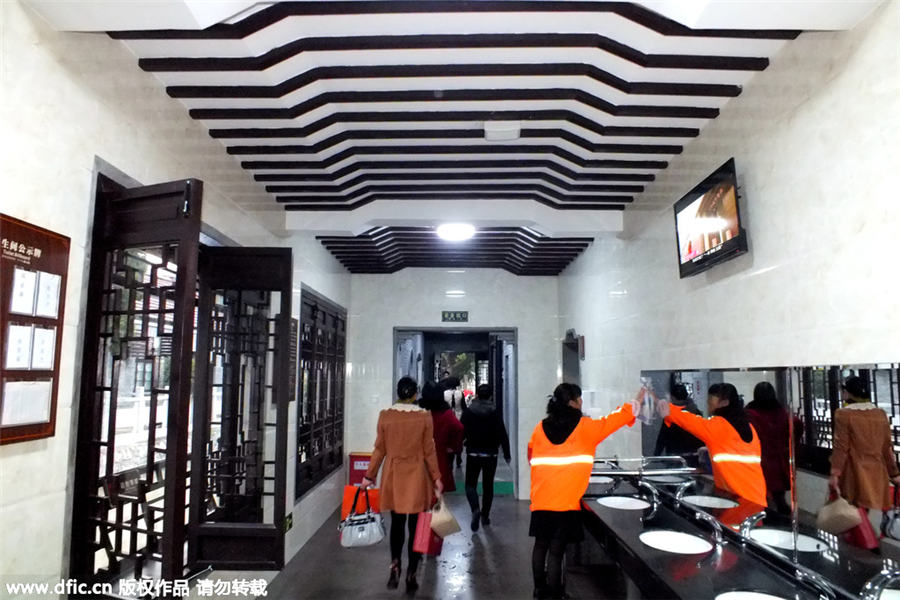
11 Jan, 2016
Clean Toilets top list of 2015 tourism developments in China
Beijing, (China Daily): 2016-01-06 — The China National Tourism Administration recently released the country’s Top 10 Tourism News of last year. The industry played a positive role in driving investment, consumption and export, as well as economic development in 2015. And the top 10 covers major events and reflects the ongoing reform and upgrading of the tourism industry in China.
1. ‘Toilet revolution’
 A public toilet at a scenic spot in Jiangsu province. [Photo/IC] |
The CNTA launched a three-year program in January called Toilet Revolution, which aims to build 33,000 restrooms across the nation by 2017 and renovate 24,000 existing facilities.
As an important measure of the “515” strategy for promoting tourism development, the “toilet revolution” has become a gigantic tourism infrastructure, civility and livelihood project in the urban-rural public service sector.
“Toilets may be small things but they reflect the level of civilization in a country,” says Li Jinzao, director of the CNTA.
2. Likely contribution to GDP: 10 percent
In 2015, internal tourism accounted for more than 4 billion visits to various sites, with a total revenue surpassing 4 trillion yuan ($615 billion). The outbound tourist total hit a record of 120 million visits. China’s domestic travels, outbound tourist visits, and domestic and outbound tourism consumption all ranked among the world’s highest.The World Travel and Tourism Council, a London-based body, estimates the contribution of China’s travel and tourism sector to the country’s GDP will be 10 percent this year, performing better than the education, banking and automobile industries. The Beijing-based National Tourism Data Center estimates the travel and tourism sector supported 10 percent of total employment in the country last year.
3. 3,000 Japanese tourists visited China
On May 23, President Xi Jinping attended the China-Japan Friendly Exchange Conference and delivered an important speech at the Great Hall of the People. Vice-Premier Wang Yang and State Council member Yang Jiechi also attended the conference. The visit of a 3,000-member Japanese tourism delegation led by Tosihiro Nikai, general council chairman of the Liberal Democratic Party, to China showed tourism diplomacy played an important role in boosting interactions and exchanges between people and serving the country’s overall diplomatic agenda.
4. Chinese tourism in South Korea
Within the framework of the “China tourism year”, the country successfully launched over 120 campaigns, making a breakthrough of 10 million visits in two-way tourism exchanges with South Korea last year.Tourism exchanges between China and South Korea were affected by the outbreak of Middle East respiratory syndrome in May, but the flow of tourists is normalizing as that shadow starts to fade. Total visits from South Korea to China touched 3.29 million from January to September, a rise of 6.8 percent compared with the same period in 2014.
5. Investment and consumption
On July 28, the Several Opinions on Further Promoting Tourism Investment and Consumption was adopted by the State Council presided over by Premier Li Keqiang, in which the tourism investment promotional plan was clearly presented for the first time. The document is of great importance as a milestone for promoting the sustained and healthy development of the tourism industry, stabilizing growth, adjusting economic structure and boosting employment.
6. Silk Road tourism
On June 19, the tourism ministerial meeting of countries along the Silk Road Economic Belt and the 7th UNWTO international meeting on Silk Road tourism was successfully held in Xi’an in Northwest China’s Shaanxi province. UNWTO Secretary General Taleb Rifai and tourism ministers from different countries associated with China’s Silk Road initiative attended the meeting.
7. ‘Tourism plus’ strategy
To make full use of the driving and integration functions of tourism and to provide a platform for the development of associated industries and sectors, the “tourism plus Internet” action plan is proposed to generate in the coming five years 1 trillion yuan in demand dividends, 1 trillion yuan in market dividends and 1 trillion yuan in value-added dividends.The development of tourism aims to promote modern urbanization and industrialization, Internet and IT applications, and agricultural modernization and ecological development.
8. Tackling ‘uncivilized’ behavior
A record of indecent tourist behavior was established to enhance regulation on tourism civility. On May 4, the CNTA released the first round of indecent tourist behavior records, and thus established the mechanism of keeping a “record of uncivilized behavior of tourists”, so as to lay an institutional foundation to enhance the supervision and regulation of ill-behaved tourists.
9. Tighter regulations
The life tenure of 5A scenic spots was abolished to activate stricter management of such locations. On Oct 9, for instance, Shanhaiguan Scenic Spot in Qinhuangdao, Hebei province, was stripped of its 5A rating. Another six scenic spots with similar ratings received serious warnings around the same time for failing to meet standards, and four scenic spots were deprived of their 4A ratings.
10. Tourism to reduce poverty
Tourism has become a major tool for poverty reduction, with rural tourism lifting tens of millions of people out of poverty.
On Aug 18, the CNTA and the State Council Leading Group Office of Poverty Alleviation and Development held a national-level meeting on rural tourism to discuss ways of reducing poverty through tourism, in Huangshan, Anhui province. There, it was proposed to lift 17 percent of the total impoverished population (about 12 million) out of poverty through rural tourism, so as to fully realize the strategic role of rural tourism.



Liked this article? Share it!